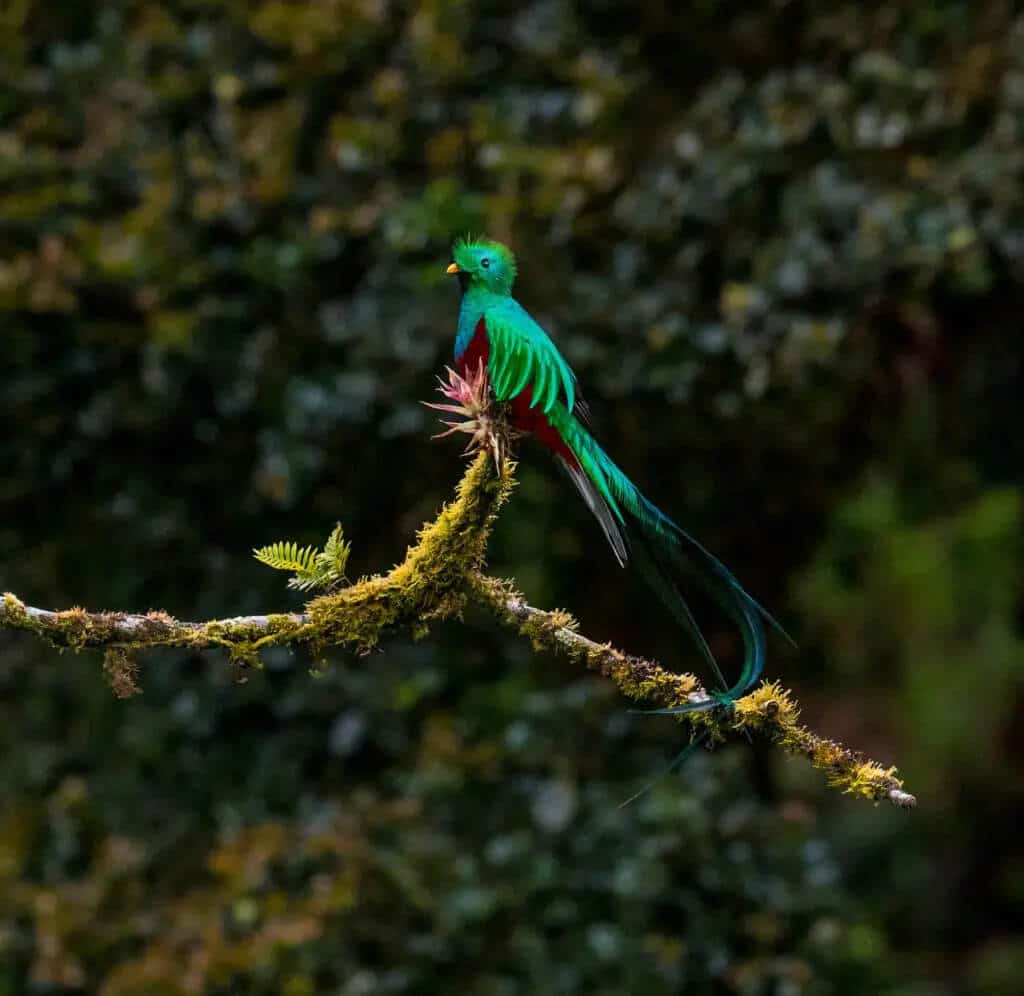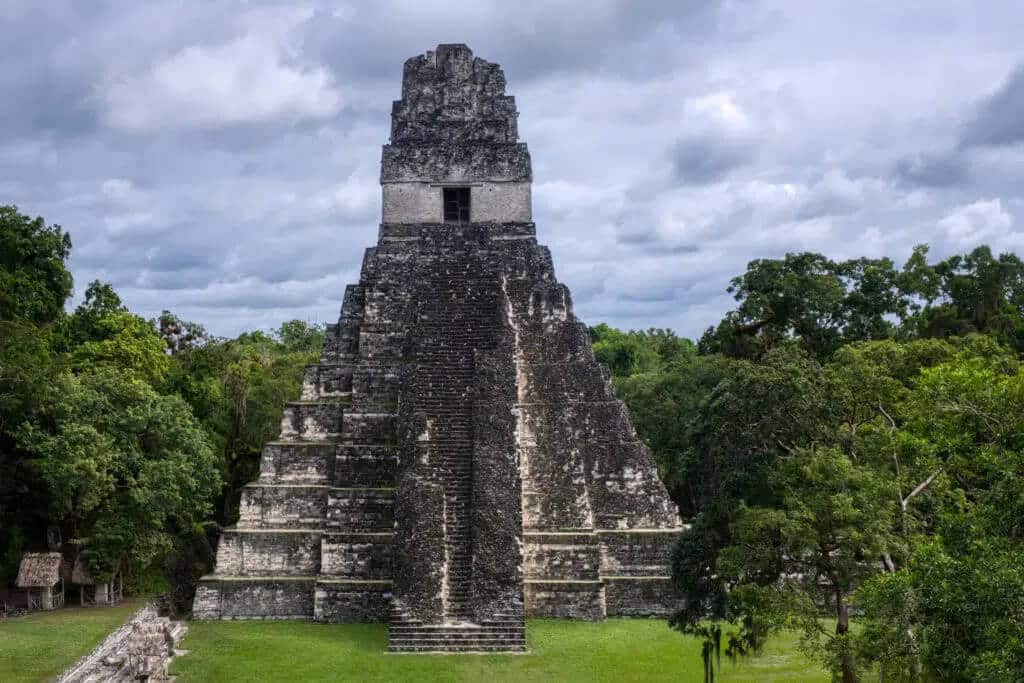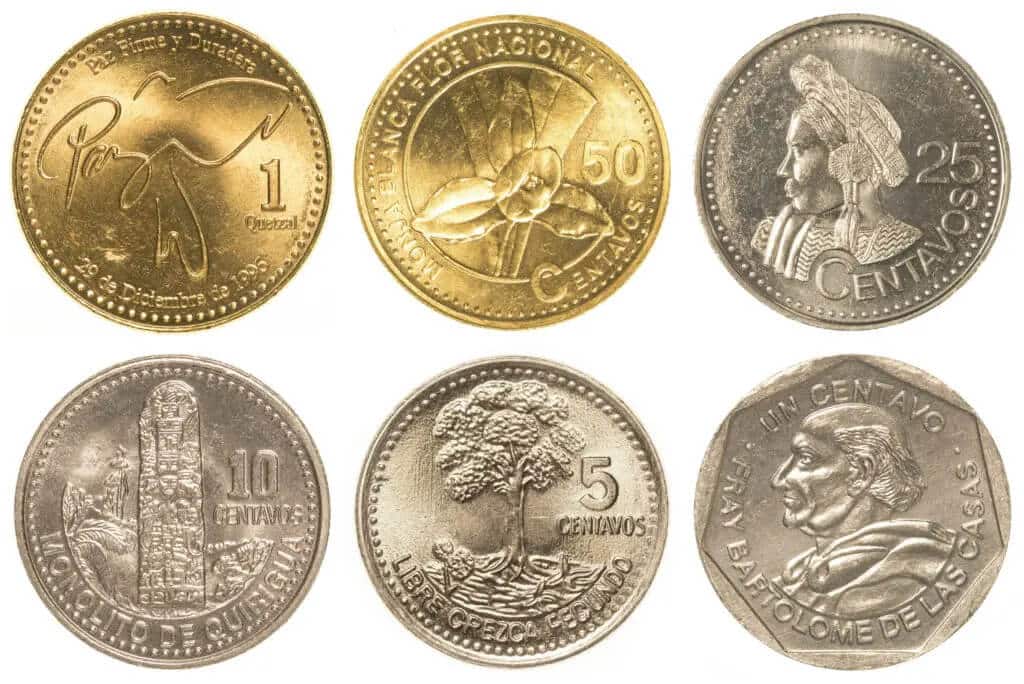Last updated on March 5th, 2024 at 10:00 pm

Guatemala is a Central American country with a rich history and vibrant culture. Every year, tourists flock there to visit its ancient Mayan ruins and scenic villages and cities, like Antigua. The small nation is also the homeland of many immigrants to the United States, Canada, and Spain. Whether you’re traveling to Guatemala, moving there, or sending an international money transfer, here’s what you need to know about the currency of Guatemala: quetzales (GTQ).
Guatemalan quetzal basics
Since it was unpegged from the U.S. dollar, the Guatemala quetzal (GTQ, currency symbol Q) has hovered in value around an eighth of 1 USD. The USD-GTQ exchange rate tends to be stable.
The quetzal is currently issued by the Central Bank of Guatemala. It’s available in the following denominations: 1, 5, 10, 20, 50, 100, and 200 quetzal banknotes, as well as 1, 5, 10, 25, 50 centavo coins, and finally, a 1-quetzal coin.
Planning to change money soon? Check out our guide to demystify exchange rates and learn some helpful tips.
The Remitly app allows you to see our competitive GTQ exchange rates instantly, whether you’re starting with USD, GBP, EUR, or CAD. Lastly, most search engines offer free currency converter tools.
The history of the Guatemalan quetzal
In colonial times, the Spanish real was the official currency used in the Central American region. After being a colony of Spain for centuries, Guatemala gained independence in 1821. After the departure of the Spanish, the country underwent significant political and social changes, a process that was reflected in Guatemala’s currency.
Newly independent Guatemala issued its own version of the real. It was used until 1859, when the country changed course and adopted the Guatemalan peso (distinct from the Mexican peso). It wasn’t until 1925 that Guatemala’s currency was finally established as the quetzal.
At the time of the quetzal’s adoption, lawmakers pegged the value of the Guatemala currency to the U.S. dollar (USD) so that the exchange rate was a simple 1-to-1 relationship. This came to an end in 1987, after the country re-established a representative democracy.
6 interesting facts about Guatemalan money

1. The quetzal is named for a symbolic bird.
Guatemala currency takes its name from the resplendent quetzal bird. This national bird of Guatemala has colorful feathers and a central role in Guatemala’s mythos. The quetzal’s brilliant green tail feathers decorated traditional Mayan headdresses, and they were so valued in precolonial times that they were sometimes used as currency.
Quetzales could not be tamed and often died in captivity, so they were a symbol of liberty as well as wealth. Today, the quetzal is a threatened species, but it still flourishes in protected habitats.
Numerous myths and legends surround the quetzal. It was sometimes associated with the Mayan god Quetzalcoatl. Among other things, Quetzalcoatl was considered a symbol of death and resurrection, not unlike the modern understanding of the myth of the phoenix.
A quetzal was also the spirit guide of the Quiché Mayan hero Tecún Umán, who fought the Spanish conquistadores. The legend says that when the hero was killed, a quetzal alighted on him. The hero’s blood stained the quetzal’s breast feathers, and according to the legend, that is why quetzals have red breasts.
2. Certain quetzal bills reflect the country’s Mayan heritage.

The hero of the quetzal legend, Tecún Umán, appears on the 50-centavo banknote. Although this bill isn’t printed anymore, it’s still in circulation. On its back is a picture of Tikal’s Temple I, an ancient pyramid that dates to the eighth century. Some call it the Temple of the Great Jaguar because a carving on a lintel in the temple depicts a king sitting on a throne shaped like a jaguar.
The temple was built as a tomb for Jasaw Chan K’awiil I, a Mayan ruler of the region. Today, the temple complex is a UNESCO World Heritage Site and a popular tourist destination.
3. The woman on the 25-centavo coin survived a war and is the only native person on a coin.
The woman on the face of Guatemala’s 25-centavo coin is Concepción Ramirez, an indigenous member of the Maya Tz’utujil ethnic group. She is the only indigenous person on a Guatemalan coin.
After posing for the coin, a job for which she was paid two quetzales, she lost most of her family in the Guatemalan civil war. That war lasted 36 years and cost 200,000 lives.
4. The one-quetzal coin features a memorial to peace.

The one-quetzal coin memorializes the peace process that ended Guatemala’s civil war. This war raged from 1960 to 1996, fought between the Guatemalan government and the Unidad Revolucionaria Nacional Guatemalteca, a union of different revolutionary groups. It ended with the Accord for a Firm and Lasting Peace on December 29, 1996.
The coin bears the image of a dove and the word “paz,” the Spanish word for peace. Along the edge are the words “Firm and Lasting Peace” and the date the peace accord was signed, as a reminder of the losses and sacrifices of the Guatemalan people.
5. Mayan script appears on the banknotes.
Though indigenous people may not appear often on Guatemala currency, the top-right corner of each quetzal banknote features the value of the bill in Mayan script.
Some historians believe that ancient Mayans may have invented the first writing system in the Americas. Unfortunately, many important examples of Mayan writing have been lost to history. We still know for sure the Mayan base-20 system used for numbers, which is now preserved with the quetzal.
6. The marimba shows up in a banknote, too.
The 200-quetzal banknote honors Guatemala’s national instrument, the marimba. Different kinds of xylophones and marimbas came to Guatemala from Africa, but the modern marimba was developed in Central America.
The front of the 200-quetzal bill has a picture of three marimba composers: Sebastian Hurtado, Mariano Valverde, and German Alcántara. On the back is a picture of a marimba and a piece of sheet music — Alcántara’s La Flor del Café.
Sending money to Guatemala

If you live abroad, sending money to Guatemala can be expensive because of exchange rate markups and hidden fees.
At Remitly, we do things a bit differently. When you use our app to send money to Guatemala from the U.S., you’ll find fair rates and low fees.
And with our coverage across Guatemala, from coast to coast, your recipients can pick up cash from familiar locations. These include Banrural, Elektra, Banco Industrial, and more. You can also send directly to a Guatemalan bank account or debit card.
